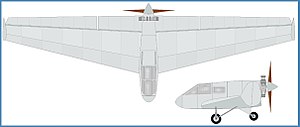ChAI-4
| ChAI-4 | |
|---|---|

|
|
| Type: | Experimental airplane |
| Design country: | |
| Manufacturer: | |
| First flight: |
October 1934 |
| Number of pieces: |
1 |
The ChAI-4 ( Russian ХАИ-4 ) is a Soviet experimental aircraft that was developed at the Kharkiv Aviation Institute in the 1930s. It is a wooden flying wing aircraft with a low wing design and a non-retractable tail wheel landing gear.
development
The machine was driven by a radial engine housed in the stern , which acted on a pusher propeller. End plates that carried the rudder were attached to the wing ends . The machine was designed for two people.
The elevators were attached to the inside of the wings, the ailerons were further out .
The first flight was in October 1934. It showed that the elevator effectiveness was far too low. It was hardly possible to get the aircraft into the air, also due to the moment introduced by the tail propeller, which pushed the nose down. The take-off speed was 180 km / h. The machine turned out to be unstable about its vertical axis, and the test pilot Kudrin had difficulties controlling it because it tended to pitch uncontrollably. When turning, the machine lost altitude immediately. Since the vertical stabilizer was not blown on by a propeller, it also proved to be inadequate in its effect.
After two more test flights, the tests were canceled because of the high risk for the pilots. Only altitudes of up to 600 m were reached.
Technical specifications
| Parameter | Data |
|---|---|
| span | 12.0 m |
| length | 4.2 m |
| Wing area | 21.25 m² |
| Empty mass | 550 kg |
| maximum take-off mass | 850 kg |
| Top speed | 180 km / h |
| Summit height | 3250 m (calculated) |
| Range | 600 km |
| Engine | a Schwezow M-11 5-cylinder radial engine |
| power | 74 kW (approx. 100 PS) |
literature
- Rudolf Storck et al. a .: Flying Wings. The historical development of the world's tailless and flying wing aircraft . Bernard and Graefe, Bonn 2003, ISBN 3-7637-6242-6 .